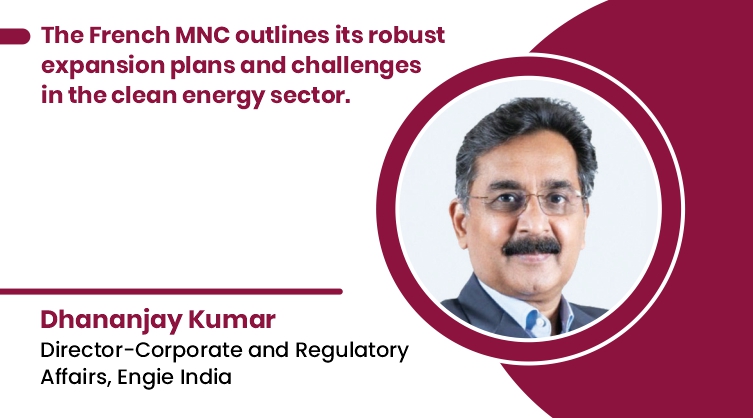Engie aims to expand in India’s renewable energy landscape
By EPR Magazine Editorial November 3, 2023 12:43 pm IST
By EPR Magazine Editorial November 3, 2023 12:43 pm IST

The French MNC outlines its robust expansion plans and challenges in the clean energy sector.
How is Engie adapting to the current energy transition landscape in India?
Engie India, a global French company, manages a 100 GW power and 38 GW renewables portfolio, including power generation, network solutions, and energy trading. In India, we have offices in Pune and Delhi, with a strong presence in renewable energy, with 1.1 GW operational assets in solar and wind and 1 GW under construction. We’ve been active in India for over a decade and have expansion plans, especially in solar and wind power.
Engie’s global energy management is launching a larger operation in India, considering segments like hydrogen. India’s skilled workforce, friendly ecosystem, and efficient supply chain make it an attractive market.
What is Engie’s strategy and commitment in India, particularly regarding renewable energy, and how does it align with India’s goals?
Engie recognises challenges in India but remains committed to deploying resources with plans to add 1 GW of capacity annually. The favourable ecosystem here is a positive factor. While hydrogen is an option, our current focus is on harnessing solar energy, possibly with energy storage. Wind assets are also considered, but our primary inclination is towards solar.
India’s goal of achieving 500 GW renewable energy capacity by 2030 is ambitious but feasible. Globally, we aim to add 5-6 GW of renewable energy annually, with a significant portion dedicated to India.
What is your take on grid stability through energy storage solutions?
Storage is vital for grid stability due to renewable energy’s intermittency, like solar and wind power, depending on weather and daylight. Grid operators manage this, but sometimes extra storage is needed. Hybrid setups, such as combining wind and solar, help but don’t eliminate intermittency.
Long-term energy storage is essential. Batteries and pump storage are options. The government aims to enhance stability by pairing battery storage with solar power for 24/7 generation. They’re also exploring battery storage integration through contracts and auctions for a reliable power supply.
The world has become a global village; can we harness this interconnectedness into the grid system?
Like the proposed transport hub connecting India to Europe, a global energy grid is feasible and beneficial. It enables the sharing of energy between regions with varying power generation, like solar and wind. Challenges exist, including geopolitics, but it’s only a matter of time.India has a resilient national grid connected to state-level grids, efficiently managed by skilled professionals at CTU and STU levels. It’s among the world’s finest grids, setting a high standard even for rapidly developing regions.
What initiatives and actions has the company taken for environmental sustainability?
ESG (Environmental, Social, and Governance) corporate responsibility for environmental sustainability is highly significant. Engie India has proactively adopted a net-zero plan in alignment with European initiatives, retiring several coal-fired and gas plants. We are committed to phasing out the remaining plants, and ESG sustainability is a core value all employees embrace.
We have confidence in India’s ecosystem for scaling up projects. We plan to explore more bilateral power purchase agreements (PPAs) and corporate PPAs for open access driven by contract quality and opportunities. Our ambitions are high, and we’re committed to making a meaningful contribution.
While Engie is not an original equipment manufacturer (OEM), we focus on developing, constructing, operating, and providing electricity. We aim to enhance engagement with OEMs to explore their products and their potential support for our liquid project.
How do the guidelines for the disposal of solar and battery waste in India address the long-term sustainability of solar projects?
Solar panels contain plastic, glass, and silica, requiring proper management. India’s Ministry of New and Renewable Energy has guidelines for solar and battery waste disposal, showing awareness and a plan. Solar projects last around 25 to 30 years, making waste disposal more relevant.
Like other types of waste, recycling and mineral preservation plans exist, alleviating concerns. The framework is in place, and following guidelines during disposal will be crucial.
Spokesperson- Dhananjay Kumar , Director-Corporate and Regulatory Affairs, Engie India
We use cookies to personalize your experience. By continuing to visit this website you agree to our Terms & Conditions, Privacy Policy and Cookie Policy.